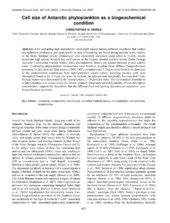Quantitative microbial ecology off the northern Antarctic Peninsula. Antarctic microbial ecology
Doctoral thesis

Permanent lenke
http://hdl.handle.net/1956/3992Utgivelsesdato
2010-06-22Metadata
Vis full innførselSamlinger
Sammendrag
The waters surrounding the South Shetland Islands, Antarctica, comprise a coastal/oceanic ecosystem that is iron-fertilized naturally from shelf sources of Weddell Sea origin. My thesis incorporates data from an 18-year time series of hydrographic, chemical and phytoplankton studies carried out during austral summer by the US Antarctic Marine Living Resources program. I show that the South Shetland Islands area is bordered by two contrasting high-nutrient, low-chlorophyll (HNLC) regions, and has an area of phytoplankton blooms that extends eastward from the shelves and shelf breaks surrounding the islands into the central Scotia Sea. As a consequence of low iron concentration, the HNLC region in the northwest sector has low surface chlorophyll concentrations but has a deep chlorophyll maximum (DCM) below the upper mixed layer. The DCM is a result of enhanced production due to elevated iron concentrations in the ferrocline, even though low ambient irradiance (hence light controlled photosynthetic rates) occurs there. The HNLC region in the southeast sector is abundant in nutrients, including iron, but has low chlorophyll concentrations resulting from deeply mixed surface waters to provide low mean ambient irradiances. The phytoplankton blooms in the central and northeast sectors occur where both HNLC sources overlap to result with surface waters having high iron concentrations and shallow mixed layers. This mixing between sources of water is described qualitatively in terms of a salinity gradient, across which the variability in chlorophyll concentration has a unimodal distribution. Maximal concentrations of chlorophyll occur at salinity ~34, and they vary among years as a function of the upper mixed layer depth that is influenced by sea surface temperature. In turn, sea surface temperature appears associated with the atmospheric climate having a global connection through the El Niño Southern Oscillation. The two HNLC areas constitute different biogeochemical provinces, and the phytoplankton community size-class composition changes between them. This change is hypothesized as a result of size-selective vs. non-selective grazing strategies of the different zooplankton assemblages that reside in each of the two provinces.
Består av
Paper I: Marine Ecology Progress Series 297, Holm-Hansen, O.; Kahru, M.; Hewes, C. D., Deep chlorophyll a maxima (DCMs) in pelagic Antarctic waters. II. Relation to bathymetric features and dissolved iron concentrations, pp. 71-81. Copyright 2005 Inter-Research. Reproduced with permission. Published version. The published version is also available at: http://dx.doi.org/10.3354/meps297071Paper II: Polar Biology 27(11), Holm-Hansen, O.; Hewes, C. D., Deep chlorophyll-a maxima (DCMs) in Antarctic waters. I. Relationships between DCMs and the physical, chemical, and optical conditions in the upper water column, pp. 699-710. Copyright 2004 Springer-Verlag. Full text not available in BORA due to publisher restrictions. The published version is available at: http://dx.doi.org/10.1007/s00300-004-0641-1
Paper III: Marine Ecology Progress Series 366, Hewes, C. D.; Reiss, C. S.; Kahru, M.; Mitchell, B. G.; Holm-Hansen, O., Control of phytoplankton biomass by dilution and mixing depth in the western Weddell-Scotia Confluence, pp. 15-29. Copyright 2005 Inter-Research. Full text not available in BORA due to publisher restrictions. The published version is available at:http://dx.doi.org/10.3354/meps07515
Paper IV: Deep Sea Research Part I 56(8), Hewes, C. D.; Reiss, C. S.; Holm-Hansen, O., A quantitative analysis of sources for summertime phytoplankton variability over 18 years in the South Shetland Islands (Antarctica) region, pp. 1230-1241. Copyright 2009 Elsevier. Full text not available in BORA due to publisher restrictions. The published version is available at: http://dx.doi.org/10.1016/j.dsr.2009.01.010
Paper V: Marine Ecology Progress Series 377, Reiss, C. S.; Hewes, C. D.; Holm-Hansen, O., Influence of atmospheric teleconnections and Upper Circumpolar Deep Water (UCDW) on phytoplankton biomass around Elephant Island, Antarctica, pp. 51-62. Copyright 2009 Inter-Research. Full text not available in BORA due to publisher restrictions. The published version is available at:http://dx.doi.org/10.3354/meps07840
Paper VI: Antarctic Science 21(5), Hewes, C. D., Cell-size of Antarctic phytoplankton as a biogeochemical condition, pp. 457-470. Copyright 2009 Antarctic Science. Reproduced with permission. Published version. The published version is also available at: http://dx.doi.org/10.1017/S0954102009990125
Utgiver
The University of BergenOpphavsrett
The authorCopyright the author. All rights reserved